写実主義
- 19世紀フランスではロマン主義の風潮に対抗し、ギュスターヴ・クールベが写実主義を主張した(レアリスム宣言)。
世界の名画。19世紀半ば頃にフランスで展開・発展した美術運動。それまでのロマン主義に対し、対象を抽象化、歪曲化、理想化せず客観的に描写することを理念とするが、その改革的な絵画展開は当時の保守層や伝統主義者らと対立した。また労働者など下層階級の人々の生活や日常を世界の現実と捉え、忠実に再現しているのも本主義の特徴である。本名称『写実主義』は、巨匠ギュスターヴ・クーベルが1855年に開催されたパリ万国博覧会の会場の隣で、「レアリスム館」を設置氏自身の個展を開催したことに由来する。
約4分鐘20秒起
Honoré Daumier (French, 1808–1879) オノレ・ドーミエ
https://ja.wikipedia.org/wiki/%E3%82%AA%E3%83%8E%E3%83%AC%E3%83%BB%E3%83%89%E3%83%BC%E3%83%9F%E3%82%A8
{杜米埃:諷刺漫畫大師}DAUMIER,廖瓊芳著, 台北:藝術家,2000/ 河北教育出版社,2001
From Wikipedia, the free encyclopedia
Not to be confused with Realism (art movement).
See also: Realism (disambiguation)
Realism in the arts is the attempt to represent subject matter truthfully, without artificiality and avoiding artistic conventions, implausible, exotic and supernatural elements.
Realism has been prevalent in the arts at many periods, and is in large part a matter of technique and training, and the avoidance of stylization. In the visual arts, illusionistic realism is the accurate depiction of lifeforms, perspective, and the details of light and colour. Realist works of art may emphasize the mundane, ugly or sordid, such as works of social realism, regionalism, or kitchen sink realism.
There have been various realism movements in the arts, such as the opera style of verismo, literary realism, theatrical realism and Italian neorealist cinema. The realism art movement in painting began in France in the 1850s, after the 1848 Revolution.[1] The realist painters rejected Romanticism, which had come to dominate French literature and art, with roots in the late 18th century.
Contents
[hide]Visual arts[edit]
Realism is the precise, detailed and accurate representation in art of the visual appearance of scenes and objects i.e., it is drawn in photographic precision. Realism in this sense is also called naturalism, mimesis or illusionism. Realistic art was created in many periods, and it is in large part a matter of technique and training, and the avoidance of stylization. It becomes especially marked in European painting in the Early Netherlandish painting of Jan van Eyck and other artists in the 15th century. However such "realism" is often used to depict, for example, angels with wings, which were not things the artists had ever seen in real life. Equally, 19th-century Realism art movement painters such as Gustave Courbet are by no means especially noted for precise and careful depiction of visual appearances; in Courbet's time that was more often a characteristic of academic painting, which very often depicted with great skill and care scenes that were contrived and artificial, or imagined historical scenes. It is the choice and treatment of subject matter that defines Realism as a movement in painting, rather than the careful attention to visual appearances. Other terms such as naturalism, naturalistic and "veristic" do not escape the same ambiguity, though the distinction between "realistic" (usually related to visual appearance) and "realist" is often useful, as is the term "illusionistic" for the accurate rendering of visual appearances.[2][3]
Illusionistic realism[edit]
The development of increasingly accurate representation of the visual appearances of things has a long history in art. It includes elements such as the accurate depiction of the anatomy of humans and animals, of perspective and effects of distance, and of detailed effects of light and colour. The Art of the Upper Paleolithic in Europe achieved remarkably lifelike depictions of animals, and Ancient Egyptian art developed conventions involving both stylization and idealization that nevertheless allowed very effective depictions to be produced very widely and consistently. Ancient Greek art is commonly recognised as having made great progress in the representation of anatomy, and has remained an influential model ever since. No original works on panels or walls by the great Greek painters survive, but from literary accounts, and the surviving corpus of derivative works (mostly Graeco-Roman works in mosaic) it is clear that illusionism was highly valued in painting. Pliny the Elder's famous story of birds pecking at grapes painted by Zeuxis in the 5th century BC may well be a legend, but indicates the aspiration of Greek painting. As well as accuracy in shape, light and colour, Roman paintings show an unscientific but effective knowledge of representing distant objects smaller than closer ones, and representing regular geometric forms such as the roof and walls of a room with perspective. This progress in illusionistic effects in no way meant a rejection of idealism; statues of Greek gods and heroes attempt to represent with accuracy idealized and beautiful forms, though other works, such as heads of the famously ugly Socrates, were allowed to fall below these ideal standards of beauty. Roman portraiture, when not under too much Greek influence, shows a greater commitment to a truthful depiction of its subjects.
The art of Late Antiquity famously rejected illusionism for expressive force, a change already well underway by the time Christianity began to affect the art of the elite. In the West classical standards of illusionism did not begin to be reached again until the Late medieval or Early Renaissance period, and were helped by the development of new techniques of oil painting which allowed very subtle and precise effects of light to be painted using very small brushes and several layers of paint and glaze. Scientific methods of representing perspective were developed in Italy and gradually spread across Europe, and accuracy in anatomy rediscovered under the influence of classical art. As in classical times, idealism remained the norm.
The accurate depiction of landscape in painting had also been developing in Early Netherlandish and Renaissance painting, and was then brought to a very high level in 17th-century Dutch Golden Age painting, with very subtle techniques for depicting a range of weather conditions and degrees of natural light. After being another development of Early Netherlandish painting, by 1600 European portraiture could give a very good likeness in both painting and sculpture, though the subjects were often idealized by smoothing features or giving them an artificial pose. Still life paintings, and still life elements in other works, played a considerable role in developing illusionistic painting, though in the Netherlandish tradition of flower painting they long lacked "realism", in that flowers from all seasons were typically used, either from the habit of assembling compositions from individual drawings, or as a deliberate convention; the large displays of bouquets in vases, though close to modern displays of cut flowers that they have influenced, were entirely atypical of 17th-century habits, where flowers were displayed one at a time. Intriguingly, having led the development of illusionic painting, still life was to be equally significant in its abandonment in Cubism.
Realism or naturalism as the depiction of ordinary, everyday subjects[edit]
The depiction of ordinary, everyday subjects in art also has a long history, though it was often squeezed into the edges of compositions, or shown at a smaller scale. This was partly because art was expensive, and usually commissioned for specific religious, political or personal reasons, that allowed only a relatively small amount of space or effort to be devoted to such scenes. Drolleries in the margins of medieval illuminated manuscripts sometimes contain small scenes of everyday life, and the development of perspective created large background areas in many scenes set outdoors that could be made more interesting by including small figures going about their everyday lives. Medieval and Early Renaissance art by convention usually showed non-sacred figures in contemporary dress, so no adjustment was needed for this even in religious or historical scenes set in ancient times.
Early Netherlandish painting brought the painting of portraits as low down the social scale as the prosperous merchants of Flanders, and in some of these, notably the Arnolfini Portrait by Jan van Eyck (1434), and more often in religious scenes such as the Merode Altarpiece include very detailed depictions of middle-class interiors full of lovingly depicted objects. However these objects are at least largely there because they carry layers of complex significance and symbolism that undercut any commitment to realism for its own sake. Cycles of the Labours of the Months in late medieval art, of which many examples survive from books of hours, concentrate on peasants labouring on different tasks through the seasons, often in a rich landscape background, and were significant both in developing landscape art and the depiction of everyday working-class people.
In the 16th century there was a fashion for the depiction in large paintings of scenes of people working, especially in food markets and kitchens: in many the food is given as much prominence as the workers. Artists included Pieter Aertsen and his nephew Joachim Beuckelaer in the Netherlands, working in an essentially Mannerist style, and in Italy the young Annibale Carracci in the 1580s, using a very down to earth unpolished style, with Bartolomeo Passerotti somewhere between the two. Pieter Bruegel the Elder pioneered large panoramic scenes of peasant life. Such scenes acted as a prelude for the popularity of scenes of work in genre painting in the 17th century, which appeared all over Europe, with Dutch Golden Age painting sprouting several different subgenres of such scenes, the Bamboccianti (though mostly from the Low Countries) in Italy, and in Spain the genre of bodegones, and the introduction of unidealized peasants into history paintings by Jusepe de Ribera and Velázquez. The Le Nain brothers in France and many Flemish artists including Adriaen Brouwer and David Teniers the Elder and Younger painted peasants, but rarely townsfolk. In the 18th century small paintings of working people working remained popular, mostly drawing on the Dutch tradition, and especially featuring women.
Much art depicting ordinary people, especially in the form of prints, was comic and moralistic, but the mere poverty of the subjects seems relatively rarely have been part of the moral message. From the mid-19th century onwards this changed, and the difficulties of life for the poor were emphasized. Despite this trend coinciding with large-scale migration from the countryside to cities in most of Europe, painters still tended to paint poor rural people, largely leaving illustrators such as Gustave Doré to show the horrors of city slums. Crowded city street scenes were popular with the Impressionists and related painters, especially ones showing Paris.
Medieval manuscript illuminators were often asked to illustrate technology, but after the Renaissance such images continued in book illustration and prints, but with the exception of marine painting largely disappeared in fine art until the early Industrial Revolution, scenes from which were painted by a few painters such as Joseph Wright of Derby and Philip James de Loutherbourg. Such subjects probably failed to sell very well, and there is a noticeable absence of industry, other than a few railway scenes, in painting until the later 19th century, when works began to be commissioned, typically by industrialists or for institutions in industrial cities, often on a large scale, and sometimes given a quasi-heroic treatment.
American realism, a movement of the early 20th century, is one of many modern movements to use realism in this sense.
Realist movement[edit]
Main article: Realism (art movement)
The Realist movement began in the mid-19th century as a reaction to Romanticism and History painting. In favor of depictions of 'real' life, the Realist painters used common laborers, and ordinary people in ordinary surroundings engaged in real activities as subjects for their works. Its chief exponents were Gustave Courbet, Jean-François Millet, Honoré Daumier, and Jean-Baptiste-Camille Corot.[5][6][7] According to Ross Finocchio, formerly of the Department of European Paintings at the Metropolitan Museum of Art, Realists used unprettified detail depicting the existence of ordinary contemporary life, coinciding in the contemporaneous naturalist literature of Émile Zola, Honoré de Balzac, and Gustave Flaubert.[8]
The French Realist movement had equivalents in all other Western countries, developing somewhat later. In particular the Peredvizhniki or Wanderers group in Russia who formed in the 1860s and organized exhibitions from 1871 included many realists such as Ilya Repin, Vasily Perov, and Ivan Shishkin, and had a great influence on Russian art. In Britain artists such as Hubert von Herkomer and Luke Fildes had great success with realist paintings dealing with social issues.
Realism or naturalism as resisting idealization[edit]
Realism or naturalism as a style meaning the honest, unidealizing depiction of the subject, can of course be used in depicting any type of subject, without any commitment to treating the typical or everyday. Despite the general idealism of classical art, this too had classical precedents, which came in useful when defending such treatments in the Renaissance and Baroque. Demetrius of Alopece was a 4th-century BCE sculptor whose work (all now lost) was said to prefer realism over ideal beauty, and during the Ancient Roman Republic even politicians preferred a truthful depiction in portraits, though the early emperors favoured Greek idealism. Goya's portraits of the Spanish royal family represent a sort of peak in the honest and downright unflattering portrayal of important persons.
A recurring trend in Christian art was "realism" that emphasized the humanity of religious figures, above all Christ and his physical sufferings in his Passion. Following trends in devotional literature, this developed in the Late Middle Ages, where some painted wooden sculptures in particular strayed into the grotesque in portraying Christ covered in wounds and blood, with the intention of stimulating the viewer to meditate on the suffering that Christ had undergone on his behalf. These were especially found in Germany and Central Europe. After abating in the Renaissance, similar works re-appeared in the Baroque, especially in Spanish sculpture.
Renaissance theorists opened a debate, which was to last several centuries, as to the correct balance between drawing art from the observation of nature and from idealized forms, typically those found in classical models, or the work of other artists generally. All admitted the importance of the natural, but many believed it should be idealized to various degrees to include only the beautiful. Leonardo da Vinci was one who championed the pure study of nature, and wished to depict the whole range of individual varieties of forms in the human figure and other things.[9] Leon Battista Alberti was an early idealizer, stressing the typical,[10] with others such as Michelangelo supporting selection of the most beautiful - he refused to make portraits for that reason.[11]
In the 17th century the debate continued, in Italy usually centred on the contrast between the relative "classical-idealism" of the Carracci and the "naturalist" style of the Caravaggisti, or followers of Caravaggio, who painted religious scenes as though set in the back streets of contemporary Italian cities, and used "naturalist" as a self-description. Bellori, writing some decades after Caravaggio's early death, and no supporter of his style, refers to "Those who glory in the name of naturalists" (naturalisti).[12]
In the 19th century "Naturalism" or the "Naturalist school" was somewhat artificially erected as a term representing a breakaway sub-movement of Realism, that attempted (not wholly successfully) to distinguish itself from its parent by its avoidance of politics and social issues, and liked to proclaim a quasi-scientific basis, playing on the sense of "naturalist" as a student of Natural history, as the biological sciences were then generally known. The originator of the term was the French art critic Jules-Antoine Castagnary, who in 1863 announced that: "The naturalist school declares that art is the expression of life under all phases and on all levels, and that its sole aim is to reproduce nature by carrying it to its maximum power and intensity: it is truth balanced with science".[13] Émile Zola adopted the term with a similar scientific emphasis for his aims in the novel. Much Naturalist painting covered a similar range of subject matter as that of Impressionism, but using tighter, more traditional brushwork styles, and in landscapes often with more gloomy weather.[13]
The term "continued to be used indiscriminately for various kinds of realism" for several decades, often as a catch-all term for art that was outside Impressionism and later movements of Modernism and also was not Academic art. The later periods of the French Barbizon School and the Düsseldorf school of painting, with its students from many countries, and in 20th-century American Regionalism are movements which are often also described as "Naturalist", although the term is rarely used of British painting. Some recent art historians have deepened the confusion by claiming either Courbet or the Impressionists for the label.[13]
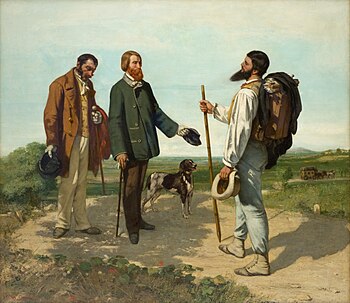
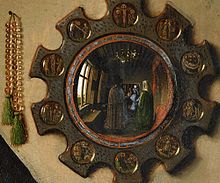


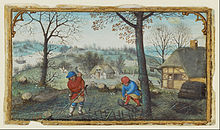













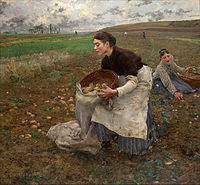

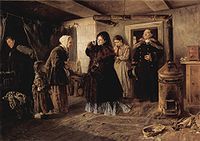





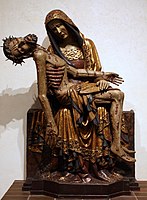

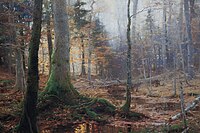

沒有留言:
張貼留言